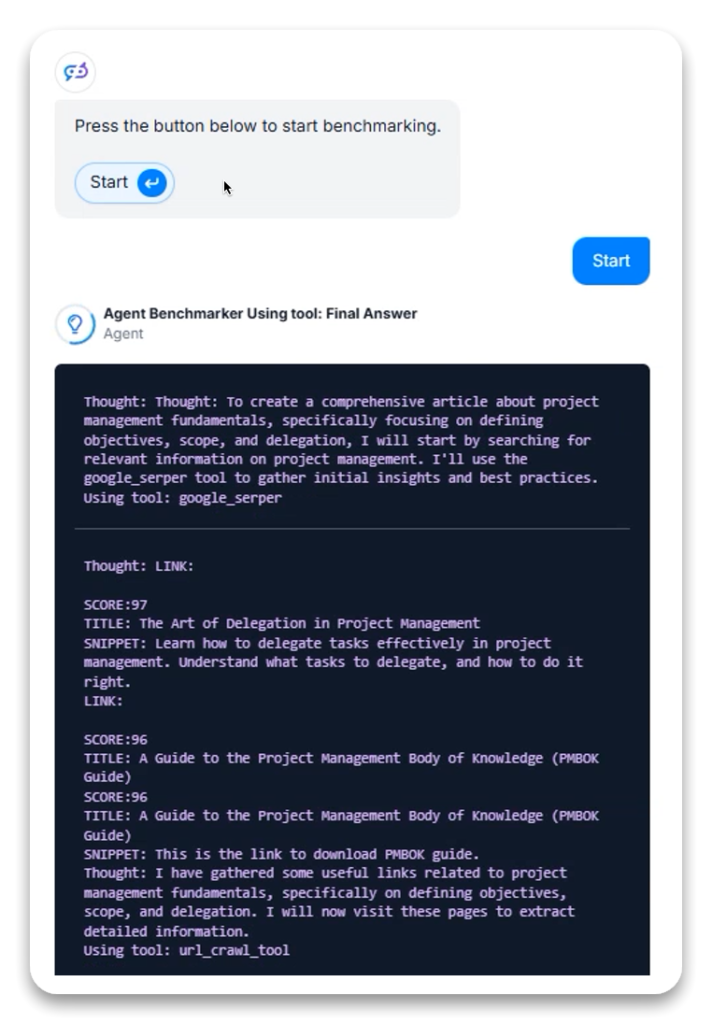In this analysis, we’ll examine Meta’s Llama 4 Scout AI model performance across five diverse tasks: content generation, calculation, summarization, comparison, and creative writing. The data reveals impressive capabilities that highlight both the strengths and areas for improvement in this AI assistant.
Task 1: Content Generation – Project Management Fundamentals
Process Overview
The Scout model demonstrated a methodical approach to content generation:
- Initial Understanding: Quickly processed the request for project management fundamentals
- Information Gathering: Used google_serper tool to find relevant sources
- Deep Research: Employed url_crawl_tool to extract detailed information
- Content Synthesis: Compiled research into a comprehensive article

Performance Metrics
- Completion Time: 24 seconds from prompt to final output
- Output Quality: Well-structured with clear headings and logical flow
- Content Depth: Covered all requested topics (objectives, scope, delegation)
- Readability: Flesch Kincaid Grade Level of 13, appropriate for professional content
- Length: 695 words of substantive content
Strengths
The model excelled at organizing information into a professional, educational format with clear headings, practical examples (like SMART objectives for CRM implementation), and actionable insights. The inclusion of references enhanced credibility and provided additional value.
Task 2: Calculation – Business Profit Analysis
Process Overview
Scout tackled this mathematical reasoning task with exceptional efficiency:
- Problem Understanding: Correctly identified the multi-part calculation requirements
- Direct Computation: Used internal capabilities rather than external tools
- Step-by-Step Reasoning: Broke down calculations with clear explanations
Performance Metrics
- Completion Time: Just 3 seconds from prompt to solution
- Accuracy: 100% correct calculations throughout
- Clarity: Explicit step-by-step explanations
Strengths
The standout aspects of Scout’s performance included:
- Assumption Handling: Explicitly stated its assumptions about sales ratios
- Mathematical Notation: Used proper mathematical notation when needed
- Logical Structure: Organized calculations in a clear sequence
- Complete Analysis: Provided both numerical answers and contextual interpretation

Task 3: Summarization – AI Reasoning Article
Process Overview
Scout demonstrated efficient information processing:
- Content Analysis: Processed a lengthy technical article about OpenAI’s o1 models
- Key Point Extraction: Identified core themes and significant information
- Concise Reformulation: Created a 94-word summary capturing essential elements
Performance Metrics
- Completion Time: 7 seconds
- Concision: Successfully condensed extensive content to under 100 words
- Comprehensiveness: Captured key themes on AI reasoning, applications, and advancements
- Readability: Average of 18.8 words per sentence with a polysyllabic word ratio of 51%
Strengths
Scout effectively distilled complex technical information into an accessible summary while maintaining accuracy and covering the essential aspects of the original text.
Task 4: Comparison – Environmental Impact Analysis
Process Overview
For this analytical comparison task, Scout employed a thorough research methodology:
- Initial Search: Used google_serper for broad information gathering
- Detail Extraction: Applied url_crawl_tool to process search results
- Refined Research: Conducted a second search for specific quantitative data
- Synthesis: Compiled findings into a structured comparison

Performance Metrics
- Completion Time: 16 seconds
- Output Structure: Clear categorical organization comparing key factors
- Depth: Comprehensive coverage of energy production, lifecycle, and emissions
- Balance: Presented advantages and limitations of both technologies
- Readability: Flesch Kincaid Grade Level of 15, appropriate for technical content
Strengths
Scout’s iterative research approach allowed it to build a nuanced comparison that acknowledged complexities (like different hydrogen production methods) while maintaining clarity through consistent structural comparisons.
Task 5: Creative Writing – Future of Electric Vehicles
Process Overview
Scout approached this creative task by:
- Scenario Development: Creating a future world (2050) with complete EV adoption
- Detail Integration: Weaving environmental and societal impacts throughout the narrative
- Balance: Including both benefits and ongoing challenges
Performance Metrics
- Completion Time: Remarkably fast at just 2 seconds
- Length Adherence: 588 words, slightly over the 500-word target
- Readability: Flesch Kincaid Grade Level of 10, making it widely accessible
- Thematic Coverage: Successfully addressed both environmental and societal impacts
Strengths
Despite not using external research tools, Scout produced a descriptive narrative that effectively incorporated factual elements regarding air quality improvements, economic shifts, infrastructure changes, and resource challenges.
Overall Assessment
Llama 4 Scout demonstrates impressive versatility across diverse task types. Its particular strengths include:
- Methodical Research: Using appropriate tools to gather information when needed
- Computational Accuracy: Perfect handling of mathematical tasks
- Efficient Processing: Quick response times across all tasks
- Structured Output: Consistent organization of information
- Balanced Perspective: Presenting multiple viewpoints in comparative tasks
The model performs exceptionally well on factual and computational tasks, with the fastest response times on creative writing and calculations. For content requiring more research, the model takes a measured approach, spending additional time to gather relevant information.
This analysis suggests that Llama 4 Scout represents a significant advancement in AI assistants that can handle diverse tasks with high accuracy, appropriate depth, and impressive efficiency.
